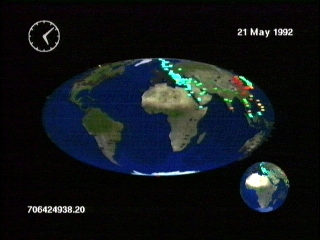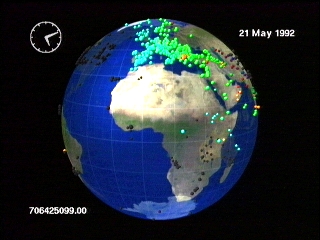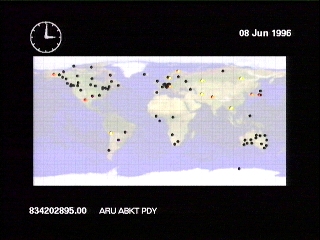


 Seismic Propagation (514k mpeg) of
a Chinese Nuclear Blast on 21 May 1992 recorded by more than 400 seismic stations.
This visualization shows the timing of the blast wavefront as the signal travels
around the world. The individual stations change color when they detect the first arrival,
from black to green for associated signals and black to yellow for
unassociated signals. The preponderance of stations in Europe and North America is clearly
evident. Notice the gap in time for stations shadowed by the Earth's core directly opposite
the blast in South America. Note also the four late arrivals from "core phases" at the very
end of the data. The clock in the upper left displays the passage of real-time for this event.
Seismic Propagation (514k mpeg) of
a Chinese Nuclear Blast on 21 May 1992 recorded by more than 400 seismic stations.
This visualization shows the timing of the blast wavefront as the signal travels
around the world. The individual stations change color when they detect the first arrival,
from black to green for associated signals and black to yellow for
unassociated signals. The preponderance of stations in Europe and North America is clearly
evident. Notice the gap in time for stations shadowed by the Earth's core directly opposite
the blast in South America. Note also the four late arrivals from "core phases" at the very
end of the data. The clock in the upper left displays the passage of real-time for this event.
 Spherical Projection (1.4M mpeg) of
the same 21 May 1992 Chinese Nuclear Blast as above, rendered on a transparent globe. The globe
rotates in such a way as to keep pace with the western-leading edge of the P phase of the
seismic energy as it arrives at the 400+ stations that turned in reports to the USGS for this
event. The clock in the upper left shows the GMT elapsed time, and the counter at the lower
left displays seconds in Unix epochal time.
Spherical Projection (1.4M mpeg) of
the same 21 May 1992 Chinese Nuclear Blast as above, rendered on a transparent globe. The globe
rotates in such a way as to keep pace with the western-leading edge of the P phase of the
seismic energy as it arrives at the 400+ stations that turned in reports to the USGS for this
event. The clock in the upper left shows the GMT elapsed time, and the counter at the lower
left displays seconds in Unix epochal time.
 08 June 1996 Chinese Nuclear Test (870K),
the last recorded nuclear test on planet earth. This animation shows the station reports
displayed on a cylindrical map projection. The time sequence begins at 2:45 GMT, 15 minutes before
the detonation at 3:00 GMT of the Chinese device. Stations which light up during this 15 minute
prelude are responding to small earth quakes, mining blasts and other local events. After the main
P phase of the seismic signal passes the stations other seismic phases can be identified arriving
at later times at some of the stations, concluding with some very late "core" phases around 3:30 GMT.
The clocks in the upper and lower left display GMT and Unix epochal time, as in the animations above.
In addition, the mnemonics of the individual seismic stations are displayed under the map as the signal
arrives at each in turn.
08 June 1996 Chinese Nuclear Test (870K),
the last recorded nuclear test on planet earth. This animation shows the station reports
displayed on a cylindrical map projection. The time sequence begins at 2:45 GMT, 15 minutes before
the detonation at 3:00 GMT of the Chinese device. Stations which light up during this 15 minute
prelude are responding to small earth quakes, mining blasts and other local events. After the main
P phase of the seismic signal passes the stations other seismic phases can be identified arriving
at later times at some of the stations, concluding with some very late "core" phases around 3:30 GMT.
The clocks in the upper and lower left display GMT and Unix epochal time, as in the animations above.
In addition, the mnemonics of the individual seismic stations are displayed under the map as the signal
arrives at each in turn.

![]() SMU Geological Sciences
Archive
SMU Geological Sciences
Archive
